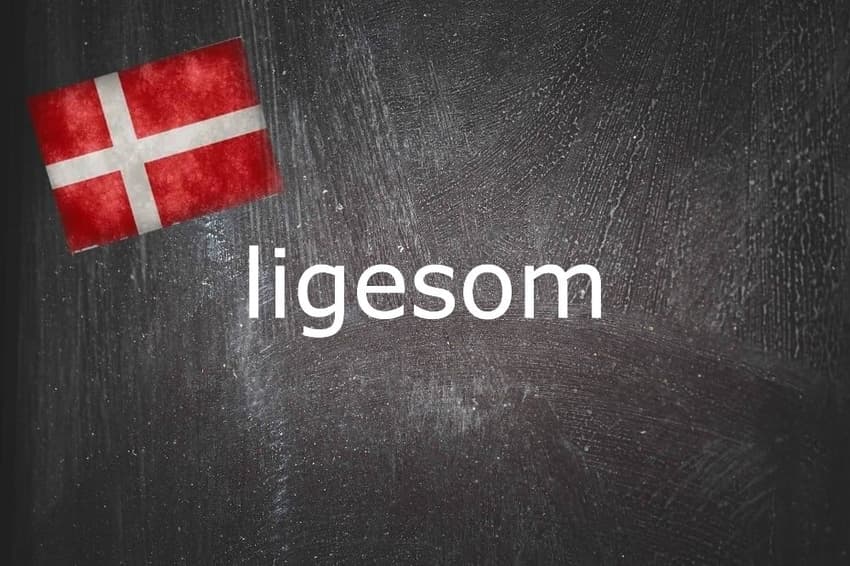Danish word of the day: Ligesom

Photo by Francesco Ungaro on Unsplash and Nicolas Raymond/FlickR
This Danish word could make you sound much more like a native, as long as you use it correctly.
What is ligesom?
Ligesom means "like", but it can't be used in all the same contexts as the English word.
There are two main situations in which you can use ligesom. The first is if you're making a comparison, in which case ligesom means "in the same way as", "just as", "similar to".
The other time you'll hear ligesom is when it's being used as a so-called filler word or discourse marker – those small words that plug gaps in sentences when you're not sure what to say next.
There are plenty of these in Danish, with the best example being altså, and they correspond to English filler words such as "like" and "um".
You'll often hear it used when the speaker is searching for the correct phrase to follow it, for example hun var ligesom... fin nok (she was, like... alright). In this sense, you could translate ligesom as "sort of" or "kind of".
As a filler word, ligesom's position in a sentence is fairly flexible; you can use it in the middle of a sentence or at the start or end: det er ligesom ikke noget, jeg gider (that’s, like, not something I want to do) or ligesom, det gider jeg ikke (like, I don’t want to do that).
As you can see, it corresponds quite closely to the way ‘like’ is used as a filler word in modern English. In fact, younger Danes occasionally go the extra step and just say ‘like’, pushing ligesom out of the sentence: Roskilde sidste år var like, det vildeste jeg har prøvet (‘Roskilde Festival last year was, like, the craziest experience’).
Why do I need to know ligesom?
As is the case with filler words in most languages, you'll occasionally hear some people grumble about the overuse of ligesom, but these particles serve a purpose by showing that the speaker hasn't finished talking yet.
They can also be used to soften a sentence, but just be aware that if you use them a lot, you might end up sounding unsure of what you're saying. And while it's a common word in spoken, colloquial Danish, especially among younger Danes, you should err on the side of avoiding it in written language.
Examples
Det er svært for mig at forstå, ligesom det er for mange andre udlændinge
It's hard for me to understand, just as it is for many other foreigners
Det der var ligesom ikke ok
That was like, not okay
Comments
See Also
What is ligesom?
Ligesom means "like", but it can't be used in all the same contexts as the English word.
There are two main situations in which you can use ligesom. The first is if you're making a comparison, in which case ligesom means "in the same way as", "just as", "similar to".
The other time you'll hear ligesom is when it's being used as a so-called filler word or discourse marker – those small words that plug gaps in sentences when you're not sure what to say next.
There are plenty of these in Danish, with the best example being altså, and they correspond to English filler words such as "like" and "um".
You'll often hear it used when the speaker is searching for the correct phrase to follow it, for example hun var ligesom... fin nok (she was, like... alright). In this sense, you could translate ligesom as "sort of" or "kind of".
As a filler word, ligesom's position in a sentence is fairly flexible; you can use it in the middle of a sentence or at the start or end: det er ligesom ikke noget, jeg gider (that’s, like, not something I want to do) or ligesom, det gider jeg ikke (like, I don’t want to do that).
As you can see, it corresponds quite closely to the way ‘like’ is used as a filler word in modern English. In fact, younger Danes occasionally go the extra step and just say ‘like’, pushing ligesom out of the sentence: Roskilde sidste år var like, det vildeste jeg har prøvet (‘Roskilde Festival last year was, like, the craziest experience’).
Why do I need to know ligesom?
As is the case with filler words in most languages, you'll occasionally hear some people grumble about the overuse of ligesom, but these particles serve a purpose by showing that the speaker hasn't finished talking yet.
They can also be used to soften a sentence, but just be aware that if you use them a lot, you might end up sounding unsure of what you're saying. And while it's a common word in spoken, colloquial Danish, especially among younger Danes, you should err on the side of avoiding it in written language.
Examples
Det er svært for mig at forstå, ligesom det er for mange andre udlændinge
It's hard for me to understand, just as it is for many other foreigners
Det der var ligesom ikke ok
That was like, not okay
Join the conversation in our comments section below. Share your own views and experience and if you have a question or suggestion for our journalists then email us at [email protected].
Please keep comments civil, constructive and on topic – and make sure to read our terms of use before getting involved.
Please log in here to leave a comment.